2006 Bloom Season
Significant regional-scale Alexandrium catenella blooms occurred in both 2005 and 2006. The 2005 event was longer, extended further to the south and had higher cell concentrations and shellfish toxicities.
Although analysis is ongoing, we see two major differences that might explain the differences in bloom magnitude and the extent of toxicity in 2005 versus 2006. The first, is a difference in the A. catenella cysts found in Gulf of Maine sediments. Cysts were approximately twice as abundant prior to the 2005 bloom (cyst map, left panel) than they were in 2006 (cyst map, right panel), which would lead to fewer vegetative cells in the water column. In addition, wind patterns in 2006 were initially very similar to those observed in 2005 but differed in mid to late May. In particular, 2005 had northeast storms in late May, whereas in 2006 the winds during that time of the month were predominantly from the southwest. The latter winds would tend to move surface waters and the associated Alexandrium cells out of Massachusetts Bay and into offshore waters. This inference has been confirmed with computer models.
Conditions in 2005 and 2006 and similarities with a massive 1972 New England red tide lead us to hypothesize that we have entered an era that will have frequent red tides and high levels of toxicity in the western Gulf of Maine and southern New England for the next decade or more.
2006 Status Reports
A survey cruise was conducted on the OSV Bold (EPA) 7-12 July in southern New England waters to investigate shellfish toxicity, along with Alexandrium abundance/distribution in the water column and cyst abundance/distribution in sediment. As Bruce Keafer (WHOI) mentioned in his earlier update on the OSV Bold cruise, FDA (Stacey Etheridge and Melissa Ellwanger) collected the shellfish for toxicity testing.
Shellfish samples were collected using a rocking chair dredge at ten locations, primarily in the area of Nantucket Shoals and Stellwagen Bank. Unfortunately, this type of dredge was not substantial enough to allow for adequate sampling. Nonetheless, with considerable effort, we were able to collect some shellfish in most locations. It is important to note that, on the basis of this and other sampling experience, it is difficult to obtain adequate samples, particularly of surf clams and other large, sub tidal shellfish, without sampling gear appropriate for the purpose. The collected samples were homogenized, extracted using the Jellett Rapid extraction procedure, and assayed for toxins using the Jellett Rapid Tests for PSP on board. Homogenates were also frozen and brought back to the FDA laboratory for further analysis.
All shellfish samples were analyzed whole except for scallops which were tested with the adductor muscle removed (unless otherwise indicated).
Special thanks to the OSV Bold, Matt Liebman (EPA), Kevin Chu (NOAA), Kerry Norton and Eric Williard (WHOI).
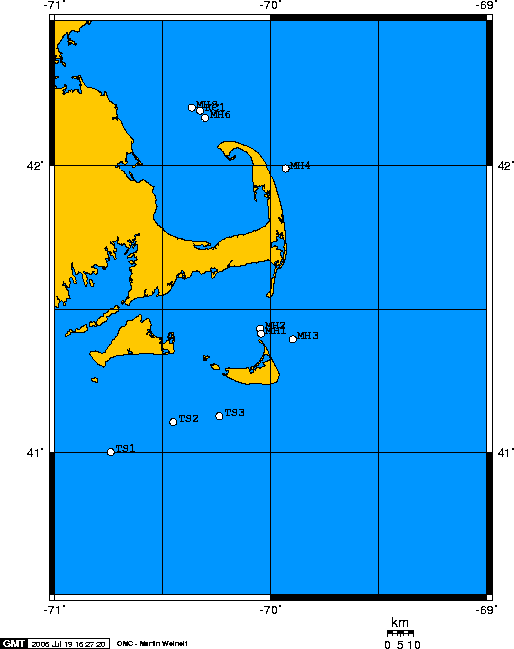
Shellfish sampling locations during the OSV Bold cruise, July 7-12, 2006. (FDA / S. Etheridge)
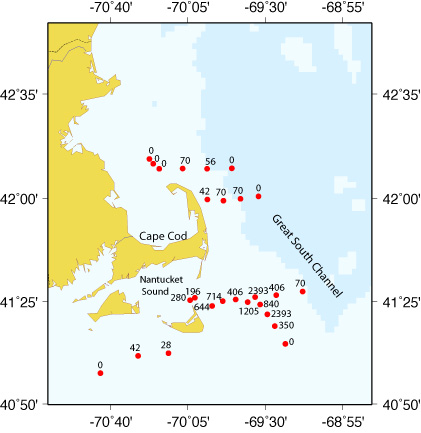
Alexandrium cell counts from OSV Bold survey, July 7-12, 2006. (WHOI / D. Anderson Laboratory)
The OSV Bold (EPA) sampled selected shellfish sites in the southern New England area for toxicity with supporting hydrographic data/water samples for Alexandrium obtained from CTD/Niskin profiles and underway stations (see map). This briefing focuses on the preliminary results from the surface live count observations.
The live counts indicated that the Alexandrium bloom in southern New England is still ongoing with a hot spot detected in the coastal current east of Nantucket Island and the Great Round Shoals Channel (i.e. east and southeast of the entrance channel to Nantucket Sound). Maximum cell counts were in the 2400 cells per liter range. The population extended to the coast and within Nantucket Sound at concentrations in the range of 200-700 cells per liter. Few cells were detected further offshore in the Great South Channel (less than 100 cells per liter). Other areas to the north and south of the hot spot including south of Martha’s Vineyard and Nantucket Islands, east of Cape Cod, and in Mass Bay near Stellwagen Bank were also low in abundance.
CTD/Niskin profiles included water samples collected as close to the bottom as possible (5 meters above bottom) to complement the shellfish samples.
Matt Liebman (EPA), Kevin Chu (NOAA), and Stacey Etheridge (FDA) may have additional information/data to share from the cruise. It was great to see the interaction and cooperation among the federal agencies during this cruise to assess the situation with offshore shellfish in southern New England.
Special thanks to Kerry Norton (WHOI), who managed the water and sediment sample collections at sea as well as the onboard live count analysis.
The OSV Bold cruise was the last scheduled cruise for this bloom season, but we are on standby should the conditions warrant further response. A Fall cruise is scheduled on October 31-November 12, 2006 on the R/V Oceanus to collect cysts from the sediments of the Gulf of Maine to produce another cyst distribution that will serve as the input to the biological/physical models for 2007. Volunteers are welcome.
The last scheduled cruise on the Tioga was completed on June 29-30, 2006. 29 stations were sampled - the full complement of stations within the Massachusetts and Cape Cod Bays sampling domain.
The bloom in southern New England is not over yet! The good news is that areas near the coast within southern Massachusetts Bay and Cape Cod Bay were clear of cells, based on the surface live counts. However, we did detect abundant populations at 3500 cells per liter along the northern boundary well offshore of Cape Ann. Two drifters were deployed into that patch; one in about 700 cells per liter near the shoreward edge and one at the peak abundance. That offshore population extends further south and east of Stellwagen Bank at maximum surface concentrations of 750 cells per liter. Higher concentrations may exist deeper in the water column as the bloom winds down. Preserved samples from 20 meters will be examined later next week to determine if that is the case. Note also that some planozygotes were detected indicating that the population is undergoing a change from asexual division to cyst formation.
One of the most interesting observations is that significant amounts of low-salinity water (29-30 psu) are still in the region and located well offshore. Surface salinities barely reached 31 psu at the outermost stations. This is likely a reflection of the record rainfall for the combined May and June period in the southern Gulf of Maine watersheds and the recent upwelling - favorable condition that has shifted the Alexandrium population and the low salinity water further offshore and away from the nearshore shellfish at this time.
We're back for one more Tioga cruise in the Massachusetts Bay region this week, especially given the second pulse of cells into the area detected during the recent Oceanus cruise that showed high Alexandrium abundances along the western Maine, New Hampshire, and Massachusetts coastlines. While the western Gulf of Maine toxicity scores continue to decline, it is possible that the cells have shifted offshore and perhaps deeper than indicated by the surface "live" counts. That offshore and deep shift occurred last year about this time as the bloom was winding down in the western Gulf. The Center for Coastal Studies will also try to sample this week east of Cape Cod, but we are currently under small craft and gale warnings that are delaying the cruise plans.
Note that as we were coming back to Woods Hole on the Oceanus, underway sampling detected several hundred cells per liter east of Cape Cod and Nantucket. The core of the Great South Channel had few, if any, cells present. This observation suggests a continuum of the coastal population to Nantucket Shoals, perhaps leading to the high Georges Bank abundance observed as the population follows the circulation (and bathymetry) out to Georges Bank in that area.
Nantucket Shoals and Stellwagen Bank will be sampled in the near future for shellfish toxins in Surf Clams and Ocean Quahogs, Alexandrium cells and cysts during a NOAA/EPA/FDA/MADMF/WHOI collaborative effort on the OSV Bold (EPA's survey vessel - Matt Liebman (EPA) and Kevin Chu (NOAA), chief scientists). That cruise leaves from Newport, RI on July 8th and returns to Boston on July 12th. So, if the bloom continues in the southern region into July, we will still have some coverage at selected areas even though the Tioga cruises are no longer scheduled past this week's cruise.
Note: In the summaries that follow, two different cell counting methods are mentioned. We use "live counts" to refer to cell enumeration done on board the survey vessel using freshly collected samples of living cells. We use "whole cell count" to refer to more accurate procedures that rely on a species-specific "probe" that identifies only Alexandrium catenella. Since this level of spcies discrimination is not possible in the live counts, these are considered rough estimates of A. catenella abundance that are useful because of their real-time nature. They give a good indication of the cell distribution of the species but the whole cell counts give us the most accurate picture.
We have now completed our initial survey from Cape Cod to the Bay of Fundy, which puts the western Gulf of Maine bloom reported earlier this week in its regional context.
Offshore waters east of Penobscot Bay were generally devoid of cells. Concentrations on the order of hundreds of cells per liter were present in the near-coastal region from the Bay of Fundy southwestward about half way to Penobscot Bay. Only a single station exceeded 1000 cells l-1 in that area, at the station southwest of the Wolves islands at the mouth of the Bay of Fundy.
We are currently transiting southwestward back to the Casco Bay region, with the aim of re-occupying the southern portion of our survey to measure the development and transport of the bloom in that region.
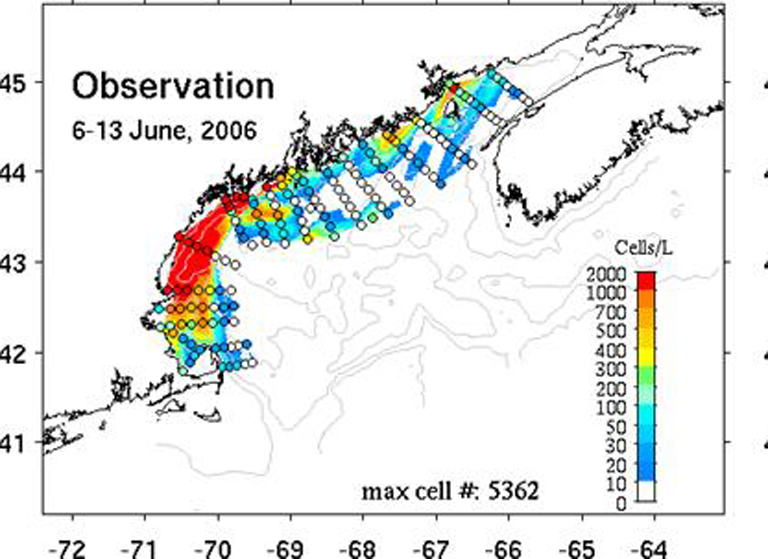
Alexandrium fundyense "live" cell counts on board R/V Oceanus as of June 13, 2006 (WHOI / D. Anderson & D. McGillicuddy laboratories) (WHOI - D. Anderson and D. McGillicuddy laboratories)
As of 1345 Sunday, our survey was complete up through the Mt. Desert line. Near coastal cell counts have declined steadily proceeding north and east from the Casco Bay line, with concentrations less than 200 cells per liter off Isle Au Haut. Our offshore most stations have begun to pick up concentrations in the 200-400 cell per liter range, comprised of mostly small cells.
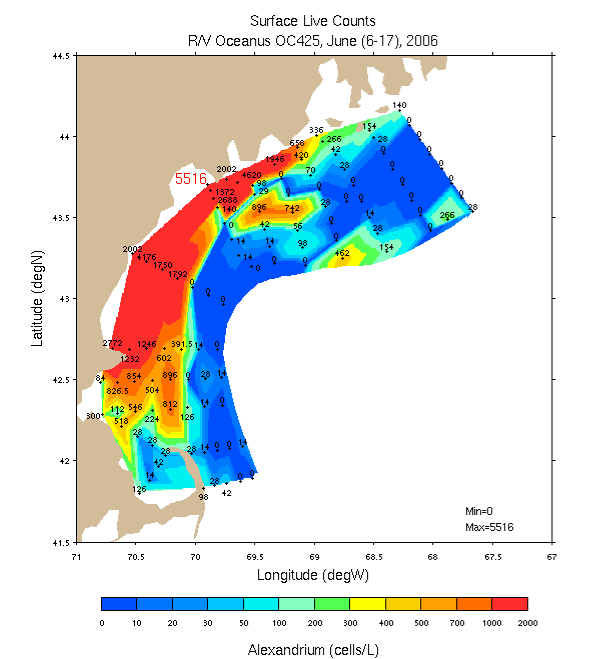
Alexandrium fundyense "live" cell counts on board R/V Oceanus as of June 11, 2006 (WHOI / D. Anderson & D. McGillicuddy laboratories)
We just wanted to give you a quick update to yesterday's message. We have now completed additional transects up to Casco Bay. Surface live counts are showing thousands of cells per liter in the near shore areas, with the highest observation of 5500 cells per liter eastern Casco Bay off Cape Small.
Greetings from R/V Oceanus. Despite some rough weather conditions we have made steady progress and have completed the Cape Cod to Cape Ann portion of our survey.
Live counts at training stations in Nantucket Sound and Great Round Shoal Channel indicated surface concentrations of 100-200 cells per liter. Concentrations of less than 100 cells per liter were observed on the back side of the Cape and inside Cape Cod Bay. We observed a significant mass of cells on the Cape Ann line, with 2700 cells per liter located inshore near Annisquam, decreasing to near zero at the outermost stations of the transect. That tongue of cells extends into northern Mass Bay, with concentrations ranging between 500-800 cells per liter on the Salem and Boston lines.
Dennis McGillicuddy and Bruce Keafer
The R/V Tioga (Cruise #185) returned to Massachusetts and Cape Cod Bays on Wed and Thurs (May 31 -June 1) for what may be the last Tioga survey of the bloom. Winds were light in the morning on both days, but picked up in the afternoon making the offshore stations a little difficult. We did manage to sample most, but not all, of the planned stations (25 of 29).
The Alexandrium abundance continues to decline rapidly with very few cells coming into the area along the northern transects. Maximum concentration in the northern Bay was about 100 cells/L at one of the offshore stations. Concentrations inshore were very low or non-detectable in the low salinity water from the nearby Merrimack (28 PSU). The diatom bloom containing Pseudo-nitzschia sp. continues along the northern stations, but appears reduced from the ballpark estimate reported last week, but no counts were completed onboard.
In the southern Bays, Alexandrium concentrations were consistently about 100-200 cells/L with a maximum of 688 at the east entrance of the Cape Cod Canal. This station is up from last week, likely due to transport of cells along the south shore further into Cape Cod Bay, but down overall compared to last week at all the other stations. Like northern Massachusetts Bay, the cell concentrations along the Boston transect are significantly down (<50 cells/L) as well, likely reflecting the further clearing out of the Alexandrium populations from the Bay with predominantly upwelling-favorable winds. This bloom in Massachusetts Bay may be over within the next week or two if the current conditions continue. There is a storm predicted for the upcoming weekend that may mix it up a bit, so stay tuned.
We expect that there are significant populations in the offshore waters along the mid-Maine coast to the Bay of Fundy. The R/V Oceanus will be leaving the dock on Tues, June 6 to sample from Cape Cod to the Bay Fundy. At the outset, 2 transects east of Cape Cod that are normally sampled by the Center for Coastal Studies and the Tioga Mass Bay stations will be resampled on or about June 7-8. We’ll let you know what we find along the way.
At this time (assuming that we do not sample again from the R/V Tioga this summer (although one more cruise is still on the books for late June), I’d like to thank all those who have helped collect samples and data on these surveys. There’s too many people to list, but the following people served duty on multiple cruises sometimes under trying and tiring conditions:
Ken Houtler (Captain, R/V Tioga)
Ian Hanley (Mate, R/V Tioga )
Kerry Norton (WHOI, Anderson Lab)
Larry Anderson (WHOI, McGillicuddy Lab)
Bethany Kirpalani (Northeastern University Coop student in Anderson Lab)
Libby Yranski ((Northeastern University Coop student in Anderson Lab)
Alfredo Arextabaleta (WHOI, McGillicuddy Lab)
Bryn Warren (Northeastern University volunteer)
And thanks to Dennis and his lab (Olga Kosnyreva) for their support and quick turnaround of the data to make the maps readily available for your viewing pleasure. Finally, our hearts go out to Jim Manning (NOAA, NEFSC) for his dedication to the drifter part of the project even when faced with the death of his mother and to Don, our fearless leader, who dealt with the passing of his brother.
Hope you found these Tioga reports informative and useful. If so, stay tuned for further updates from the R/V Oceanus cruise next week,
Bruce Keafer
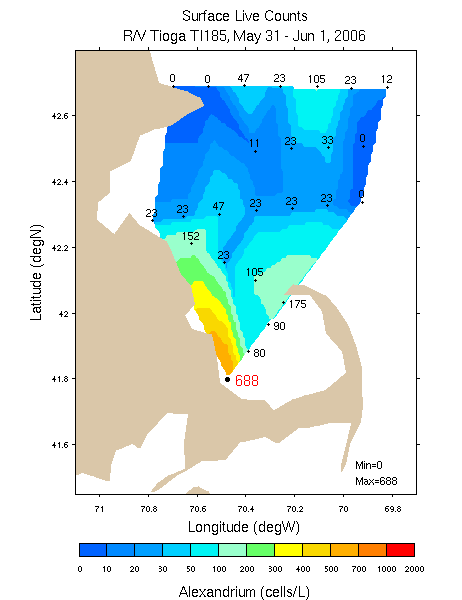
Alexandrium fundyense cell counts, on board R/V tioga, May 31 - June 1, 2006. (WHOI /D. Anderson laboratory)
The University of New Hampshire's group onboard the R/V Gulf Challenger collected samples last week in New Hampshire and western Maine coastal waters (May 23-24). Whole cell counts indicate that the nearshore Alexandrium catenella population was very low (<50 cells/L). The the outermost station was only about 200 cells/L, but increasing working offshore (see map). The R/V Gulf Challenger did not reach the outer edge of the population, so we don't know how many cells are beyond that point. This result is consistent with the "live" count observations reported late last week from the R/V Tioga in the northern part of Massachusetts Bay. The persistent upwelling favorable breezes have shifted the population offshore and reduced its intensity.
Meanwhile, the Center for Coastal Studies at Provincetown sampled the "backside" of Cape Cod from the R/V Shearwater last week (May 25). Whole cell counts indicated that about 300-700 cells/L were observed nearshore (within 10-15 miles of the coastline) east of Cape Cod (see map), about the same concentrations that were observed on the other side of the Cape within eastern Cape Cod Bay on R/V Tioga last week. So, it appears that some of the cells that were in Massachusetts and Cape Cod Bays over the last few weeks are exiting the area around Cape Cod. While the drifters deployed in Massachusetts Bay two weeks ago are headed offshore east of Cape Cod towards Georges Bank, the Alexandrium population east of Cape Cod is located primarily in the nearshore areas of that region. The population is significantly reduced at the offshore stations, but as noted above, we don't know what is beyond our sampling domain to the south and to the east.
Overall, the expanded picture developed from the set of last week's cruises shapes up as one of relatively low cell abundances (up to a couple hundred cells/L) in western Maine, New Hampshire and northern Massachusetts Bay with an offshore shift of the population. Significant populations (from hundreds to several thousand cells/L) still remain in southern Massachusetts Bay, Cape Cod Bay, and east of Cape Cod. Finally, due to the shift from persistent downwelling-favorable conditions in early May to persistent upwelling-favorable conditions in late May, the bloom doesn't appear to be reaching the record levels observed last year in southern New England at this time, but don't let your guard down, As more results become available, we will try to keep you informed of what's happening offshore.
R/V Tioga is out again in Massachusetts Bay on Wednesday and Thursday this week (May 31-June 1). The outer Cape will also be sampled again this week by the Center for Coastal Studies, if the weather cooperates. In the following weeks (June 6-17), the large WHOI ship, R/V Oceanus weighs in with a survey from Cape Cod to the Bay of Fundy. For that cruise, reports of "live" counts will continue by e-mail contact directly from ship to shore.
The R/V Tioga (Cruise #184) returned to Massachusetts and Cape Cod Bays on Wed and Thurs May 24-25 for another Alexandrium survey during relatively good weather. Generally, the Alexandrium abundance was reduced in the northern Bay with populations remaining in the southern Bays. There was plenty of other phytoplankton biomass present due to an ongoing diatom bloom (which included Pseudo-nitzschia sp.). Concentrations of Psuedo-nitzschia were not determined onboard, but is in the 10,000 cells/L ballpark.
Onboard “live” counts indicated that the highest concentrations of Alexandrium are now primarily located in a patch just off Boston at concentrations of about 2000 cells/L (in salinities of about 29.5), slightly up from last week at that station. The abundance decreased rapidly offshore across that transect with few cells observed when the salinity increased above 32 PSU east of Stellwagen Bank. Unlike near Boston, Alexandrium concentrations in western Cape Cod Bay near the east entrance to the Cape Cod Canal were at least an order of magnitude lower than last week (1500 cells last week vs <50 cells/L this week), but remained about the same in the eastern half of CC Bay (300-600 cells/L). This observation suggests that the upwelling-favorable conditions (persistent breezes out of the south and west) that occurred over the last week shifted the cell population away from that part of the coast to the eastern part of CC Bay near the tip of Cape Cod.
In the northern part of the Bay, the Alexandrium population was low compared to last week. Furthermore, the extremely low salinity flood waters observed last week from the Merrimack River have now abated. The lowest salinity waters were primarily confined to the inshore stations near Cape Ann and contained few Alexandrium cells (<50 cells/L). The maximum cell abundances along that transect were shifted offshore with the highest cell abundance (about 200 cells/L) observed in waters of about 31.5, the outer edge of the coastal freshwater plume. The highest populations (1000-3000 cells/L) observed last week in the nearshore waters south of Gloucester, MA were not present during this week’s survey. In that area, the maximum cell number observed was in the 100-300 cells/L range, an order of magnitude lower than the previous week. Again, this result is not totally surprising given the upwelling favorable conditions and the observed paths of the drifters that were deployed in that population last week. One drifter, deployed on the inside edge of the freshwater plume at 1000 cells/L is now offshore near Georges Bank. Two other drifters, deployed in a 2000-3000 cells/L patch, are now east of Cape Cod. We did not deploy drifters on this cruise (several are now being refurbished from the earlier deployments), but will deploy more as they become available.
It now appears that the bloom in Massachusetts Bay has cleared somewhat and is not being replenished in high concentrations from the north (at least not near Cape Ann at this time). The population in the southern Bays may exit out near Provincetown at the tip of the Cape in the weeks ahead if the current conditions persist. To determine if an Alexandrium population exists near the outer Cape Cod region along the pathway of the drifters, the Center for Coastal Studies sampled 2 transects east of Cape Cod on Thursday, May 25 and will sample again next week. Note also that R/V Gulf Challenger (UNH) also sampled out from Portsmouth, NH and along the western Maine coast —yes, the better weather is finally here and all boats were out this week. Those results will be available sometime next week.
You can be sure there are Alexandrium populations offshore of the Maine coast at this time of year (but we don't know how much), so we are not out of the woods yet. To resolve that unknown, we are planning to mount an effort in those waters in early-mid June---so stay tuned.
To follow previously deployed drifters, click here.
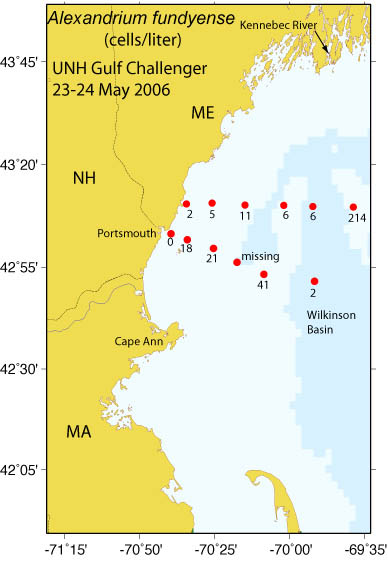
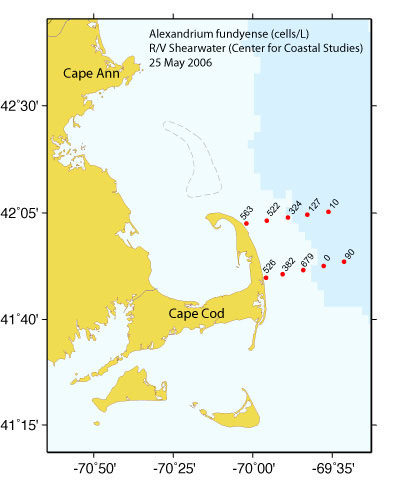
Alexandrium fundyense cell counts from Center for Coastal Studies (Provincetown) survey, May 25, 2006. (WHOI / D. Anderson laboratory,
Center for Coastal Studies, Provincetown)
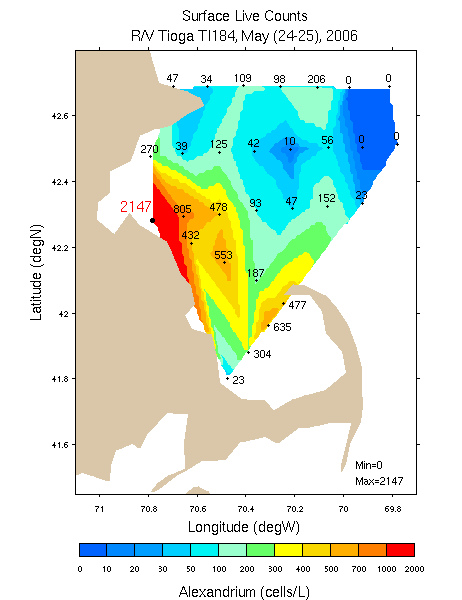
Alexandrium fundyense cell counts from survey of Massachusetts Bay, May 24-25, 2006 (WHOI / D. Anderson laboratory)
Alexandrium fundyense cell counts from UNH R/V Gulf Challenger survey, May 23 - 24, 2006. (WHOI / D. Anderson laboratory
UNH / R. Morrison)
The R/V Tioga managed to sample on Wed and Thurs May 17-18 in Massachusetts Bay and Cape Cod Bay.
Onboard “live” counts for Alexandrium indicated that the population increased over the last week within the Bays. Counting was difficult due to the weather and the presence of a related species, Alexandrium ostenfeldii and large Scripsiella sp., so the following numbers may be biased a little on the high side. Confirmation of the "live" counts will be reported next week.
Highest concentrations in the southern Bay (sampled May 17) were observed close to the coast at 1500 cells/L near the east entrance to the Cape Cod Canal and off Boston. On the transect east of Boston to Stellwagen Bank, the population was consistently about 1,000 cells/L--up from about 500 cells/L last week. Near Provincetown, we observed about 500 cells/L, up significantly in the eastern part of Cape Cod Bay. The Center for Coastal Studies also sampled in Cape Cod Bay on Thursday and those results will be available next week.
In the northern part of the Bay (sampled May 18), there was a tremendous amount of freshwater in the sampling domain as might be expected from the flooding Merrimack discharge. Salinities as low as 25PSU were detected well offshore of Cape Ann as that plume influenced the northern Bay. Alexandrium sp. concentrations were low near Annisquam (40 cells/L and 26 PSU), but increased offshore to about 600 cells/L at 30.5 PSU on the eastern side of the freshwater plume, dropping off when the salinity reached 32 PSU at the outermost stations. Just south of Gloucester, we located a patch of 2000-3000 cells/L, also in a salinity of 30-30.5 PSU. These cells were located on the western side of the freshwater plume. Concentrations further offshore in the lowest salinity surface waters of the plume (25 PSU) were 500 cells/L and increased to about 1000 cells/L at the outer edge of that plume—So, the freshwater plume appeared to split the surface population in the northern Bay, a result similar to historical observations offshore of Casco Bay, MA due to the outflow from the Kennebec River plume.
Three surface drifters were deployed in a patch of 1000-3000 cells/L (30.5 PSU), south of Gloucester. The most offshore drifter (drifter 6) of that set was deployed on the shoreward edge of the freshwater plume at 27.5 PSU in about 1000 cells/L.
Fortunately, the weather is changing from a persistent onshore flow to an offshore flow with SW winds predicted for the duration of the week. R/V Gulf Challenger (UNH) was scheduled to sample early this week, but could not get out due to the unsettled weather condition. R/V Tioga (WHOI) will be sampling Wed and Thurs this week in Mass Bay. We’re expecting to observe plenty of freshwater runoff within the Bay, especially near Cape Ann due to the outflow from the nearby Merrimack River. It should set-up an interesting stratified condition with concentrations of Alexandrium cells already detected within the Bay last week. Stay tuned for those results later in the week.
Analysis of the Whole Cell (WC) preserved samples collected on May 11 last week confirmed the onboard “live” counts where a significant population of Alexandrium catenella was detected within Mass Bay. Maximum WC concentrations were about 900 cells/L at two locations 5-10nm off of Boston and the South Shore, similar to the maximum reported live count of 1100 cells/L. Lower concentrations were observed at all stations in Cape Cod Bay (<200 cells/L), again, similar to the “live” counts. After the weekend storm condition, all three drifters moved toward the coast and grounded along the South Shore within a few days of their deployment suggesting that the population will be close to the coast and will likely be transported into CC Bay from adjacent areas of western Mass Bay. Jim Manning (NOAA) is recovering those drifters and we hope to have a new drifter set in the same area of the bloom this week.
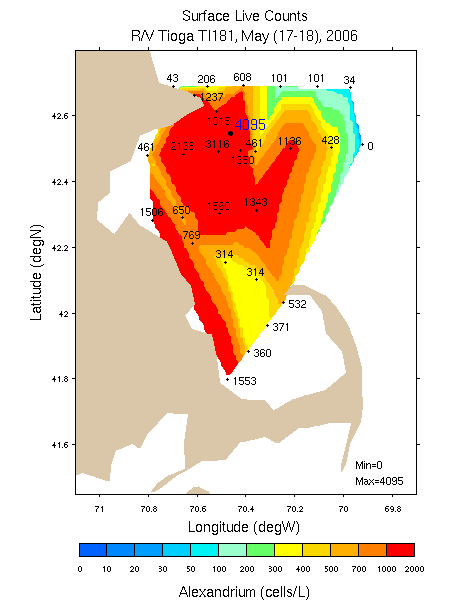
Map of Alexandrium cell counts from Massachusetts Bay survey, May 17-18, 2006. (WHOI / D. Anderson laboratory)
In the lull yesterday, 12 stations were sampled in Cape Cod and Massachusetts Bay. We were not able to sustain the effort into the northern area off Cape Ann, due to the unfavorable weather conditions today.
Live counts indicated that there is now a significant population of Alexandrium sp. in the Bays. Across the Boston transect to the east of Stellwagen Bank, concentrations were consistently about 500 cells/L with 1100 cells/L detected at one station (about 10nm east of Boston). Consistent with earlier observations, when the salinity increased to 32 offshore east of Stellwagen Bank, the cell concentration dropped off drastically to below detection limits. Cell concentrations were lower in Cape Cod Bay with the highest concentrations (125 cells/L) observed in the western part of the Bay near the east entrance of the Cape Cod Canal. This situation is not unlike the conditions at the beginning of the major Alexandrium bloom in the spring of 2005—cell concentrations high enough to cause toxicity within Mass Bay under persistent NE flow. Current cell concentrations are about half of those detected at this time in 2005 (consistently 1000 cells/L in 2005 vs 500 cells/L in 2006). Coincidentally, the detection of this bloom occurred on the one year anniversary (nearly to the day) of last year’s record bloom. The next few weeks will be critical is determining the intensity and fate of the bloom. Cruises are scheduled weekly during the May period. Next cruise is May 17-19. Stay tuned for further updates.
Also note that drifters were deployed at 3 sites within Mass Bay embedded within the Alexandrium population. The most inshore drifter was deployed within the highest cell concentration (1100 cells/L), while the other 2 drifters further offshore were deployed in concentrations at about 500 cells/L. At either side of the drifter set (both inshore and offshore, the adjacent station indicated concentrations were about 500 cells/L, so we are confident that the drifters are in the broad patch -for now anyway.
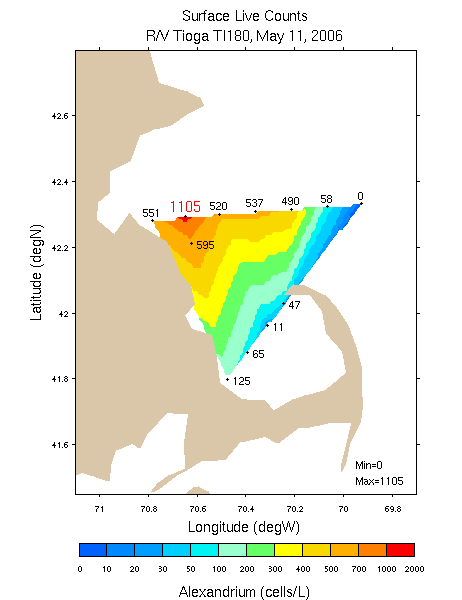
Alexandrium cell counts from Massachusetts Bay survey, May 11, 2006. (WHOI / D. Anderson laboratory)
Samples were collected on Monday May 8, 2006 by Ru Morrison's group at UNH from the R/V Gulf Challenger and analyzed here at WHOI (using the whole cell probe method). The map depicts Alexandrium catenella cell counts posted next to the station locations sampled earlier this week.Across the transect out from Portsmouth, NH, the A. catenella population is now in the 100-300 cells/L range with the maximum concentration offshore east of the Isle of Shoals decreasing to near detection limits further offshore near Jeffrey's Ledge and Wilkinson Basin. The earlier report near Cape Ann on April 25-26 (two weeks ago) indicated cell concentrations near the lower end of that range --about 100 cells/L. These numbers are likely to increase in the coming weeks.
We are desparately trying to get offshore this week on the R/V Tioga, but the continuing NE flow has held us back (10 ft seas earlier today). A brief lull (if you can call it that at 4-6 ft seas) might give us a short opportunity to sample tomorrow in Massachusetts Bay before the next major storm. We'll stick our nose out into the Bay to see what's happening there and will report back when we have samples and data.
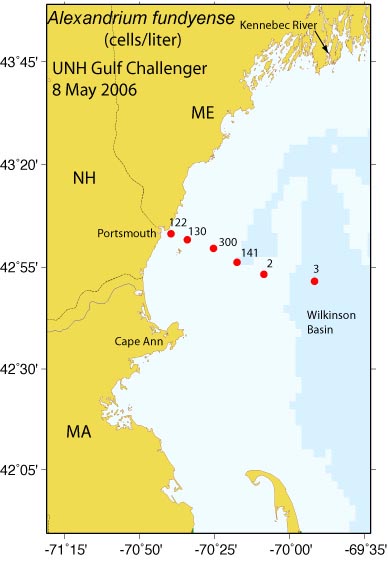
Alexandrium cell count data from UNH cruise, May 8, 2006. (WHOI / D. Anderson laboratory)
We have verified a few of the "live" cell counts reported near Cape Ann from last week (April 25-26) using a whole cell (WC) hybridization method for identification and enumeration. The whole cell numbers provide a greater degree of confidence in the counts due to the low detection method (1 cell/L -WC vs. 12-35 cells/L - 'live") and the specificity of the molecular probe that easily distinquishes Alexandrium catenella without confusion with Alexandrium ostenfeldii.
Along the Cape Ann transect, two of the innermost stations near the coast and within low salinity waters (<31) indicated about 70-100 cells/L compared to only one station just northeast of Cape Ann that indicated 145 cells/L reported last week based on the "live" counts--similar ballpark in concentration at that one station, but this update suggests the low concentration Alexandrium fundyense patch extended further inshore to the coastline (and near the Annisquam River where shellfish toxicity is routinely monitored).
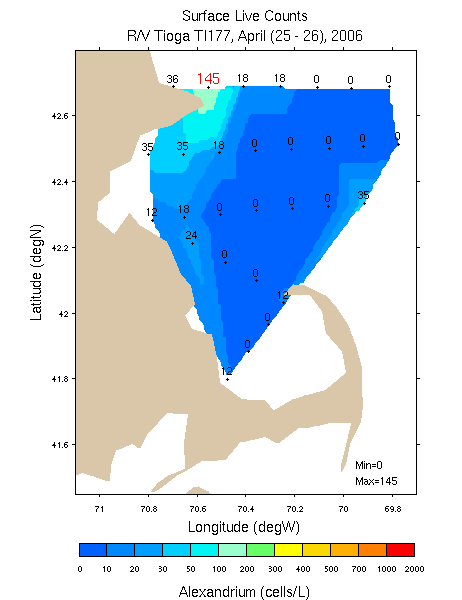
Alexandrium survey, Massachusetts Bay, April 25-26, 2006. (WHOI / D. Anderson laboratory)
The WHOI group completed its first Massachusetts Bay survey for Alexandrium. The weather cooperated and we were able to examine samples while at sea. Based on onboard "live" counts from concentrated samples near the surface, the Alexandrium abundance was extremely low with only 0-20 cells/L cells detected at any given station (see map). Alexandrium was consistently observed in Cape Cod Bay at the southern end of the sampling domain, while along the northern boundary, we did not detect any incoming Alexandrium cells. These levels were at the limits of detection of our onboard methods and equated to only 0-2 cells actually observed under the scope (1 cell observed = about 10 cells/L), so there is no real difference between the two regions of the Bay.
Other dominate phytoplankton included Phaeocystis and various typical spring diatom species. Psuedo-nitzschia sp. was rare. The Phaeocystis bloom consistently limited the amount of water that we could pass through our 20µm sieves for the live count (usually 10-12L but we dropped that volume back to only 4L). It was particularly intense at the nearshore station at Cape Ann off the Annisquam River mouth. Note also that the Phaeocystis intensity across the northern boundary increased our detection limit for the live count (by reducing the volume sieved) which could be one reason that no cells were observed there.
Our next cruise is scheduled for 23-25 April. That cruise will follow on the heals of a UNH cruise and may provide a good picture of any early bloom development that may occur as the water begins to warm in the next week or two.
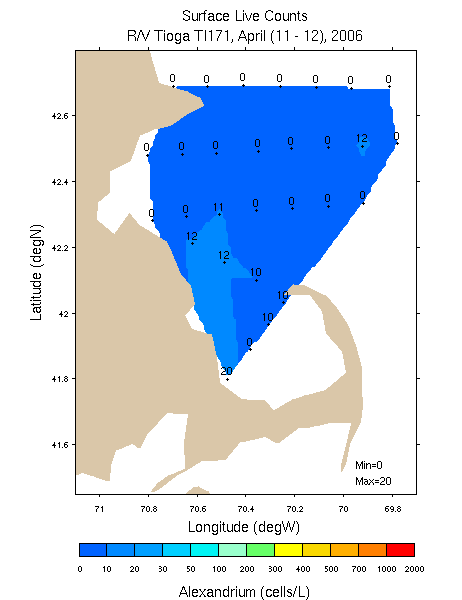
Alexandrium cell counts from Massachusetts Bay survey, April 11-12, 2006. (WHOI / D. Anderson laboratory)
Dr. Rue Morrison at UNH is providing Alexandrium samples from the coastal waters to the Anderson Lab at WHOI for analysis. The stations are sampled from the R/V Gulf Challenger along a transect out from Portsmouth, NH to Wilkinson Basin about every few weeks. An alongshore transect is also sampled that extends to the Kennebec River mouth in Maine, a hot spot for Alexandrium cell accumulations either within the plume or at the plume front.
Surface samples from the most recent cruise on March 22-23, 2006 showed Alexandrium catenella was present in extremely low concentrations (1-2 cells/Liter). (See map.) The next set of samples will be collected during the week of April 18th.
The WHOI group will begin sampling on the R/V Tioga in Massachusetts Bay next week (April 11-13) and continue throughout the spring.
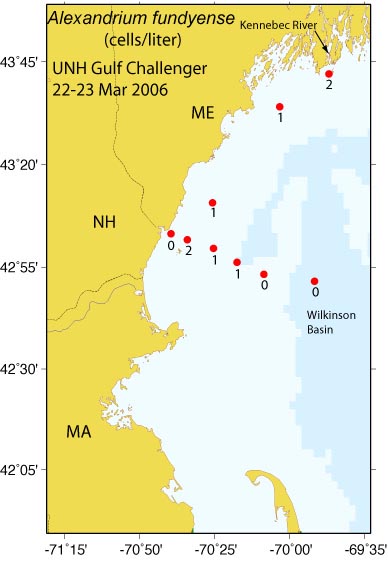
Alexandrium cell counts from UNH survey, March 22-23, 2006. (WHOI / D. Anderson laboratory
UNH / R. Morrison)
Here’s an update from the Massachusetts coastal waters based on data collected by the WHOI-HAB group during R/V Tioga cruise 177 (April 25-26).
After a weekend storm that lingered into Monday, we were able to sample on Tues. and Wed. and managed to complete most of the stations within our sampling domain (29 stations; same as during Tioga cruise 171 reported on April 13, 2006).
Most of Massachusetts Bay and Cape Cod Bay continue to show Alexandrium sp. concentrations at or near detection limits based on the “live” count method (12-35 cells/L). However, at one station located just offshore of Cape Ann (2-3 nm northeast of Rockport, MA; see map), we detected a significant population above background (145 cells/L; based on 9 cells actually observed under the microscope). The surface temperature and salinity at that station was 7.5 C and 30.6, respectively, indicative of river runoff (warmer and less-saline than Gulf of Maine receiving waters). At the next station offshore along that transect, the temperature decreased to 6.3 and the salinity increased to 32.1, while the population declined to background levels. This observation indicates that the Alexandrium cells are likely coming from along the Maine/NH coast and are now poised to enter Mass Bay at its northern boundary. At this time, we don’t know how many cells are off the Maine coast and won’t know that information until the second week in May during a scheduled cruise on UNH’s R/V Gulf Challenger (see below).
Whole cell counts from preserved samples are currently being processed and will be reported when those results become available.
Notes on other phytoplankton: Phaeocystis is still clogging our sieves contributing to the variable detection limit of the “live” count method as we filter less water at most of the stations. Diatoms were rather sparse in the surface waters. The mixed diatom bloom was not dominant, unlike the last cruise (Tioga 171). Rhizosolenia sp. became the dominant diatom at the most offshore stations, with while Phaeocystis clogging problem was reduced. Pseudo-nitzschia sp. was not noticed in the “live” count for Alexandrium.
The next R/V Tioga cruise is scheduled for May 10-13. The UNH group was not able to sample later in April due to engine repairs to the R/V Gulf Challenger. That group plans to resample the waters along the Maine and NH coastlines on May 8-9. Until then, be alert as we are reaching a critical time in bloom development in the western Gulf of Maine.
Be aware that the weather forecast for next week calls for general NE flow from a low pressure system that may back into New England perhaps leading to rapid transport of any cell population along the Maine coast and into Mass Bay associated with the downwelling-favorable conditions.
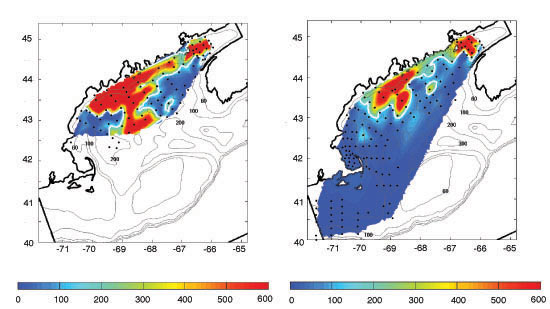
Gulf of Maine cyst abundance prior to 2005 bloom (left) and prior to 2006 bloom (right). (units=cysts/cm3) (D. Anderson/WHOI)
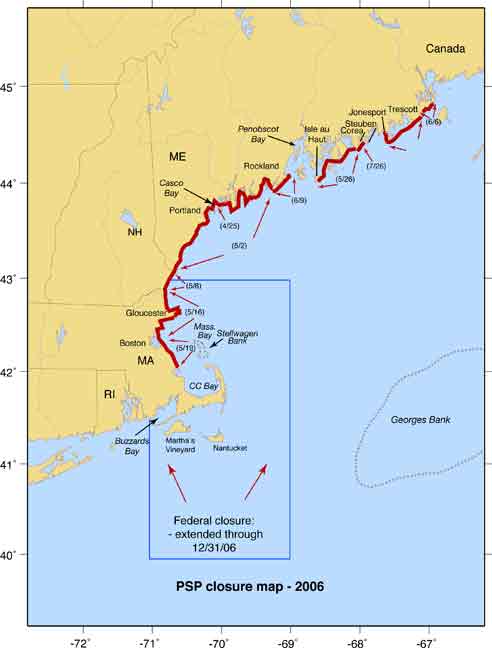
Mussel harvesting closure areas along the New England coast during 2006. Compiled from information provided by the Massachusetts Division of Marine Fisheries, the New Hampshire Department of Environmental Services, and the Maine Department of Marine Resources.
(WHOI / D. Anderson laboratory)
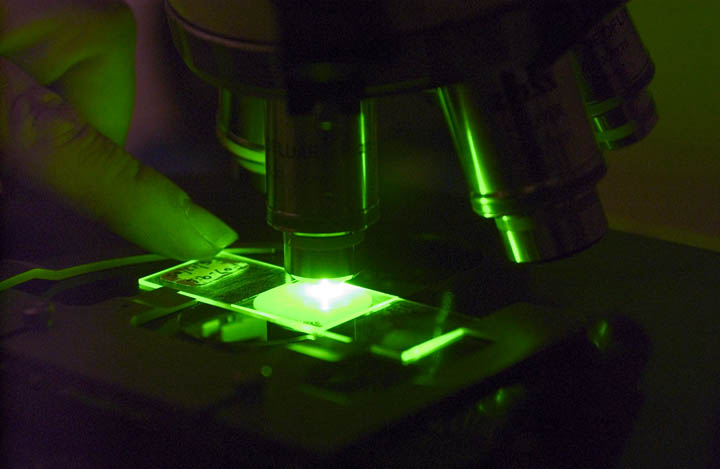
The Anderson laboratory uses epifluorescence microscopy using "molecular probes" to positively identify and enumerate Alexandrium fundyense. For more information about this process, please see the following publication:
Anderson, D.M., D.M. Kulis, B.A. Keafer, K.E. Gribble, R. Marin, and C.A. Scholin. 2005. Identification and enumeration of Alexandrium spp. from the Gulf of Maine using molecular probes. Deep-Sea Res. II 52(19-21): 2467-2490. (Tom Kleindinst, WHOI)
